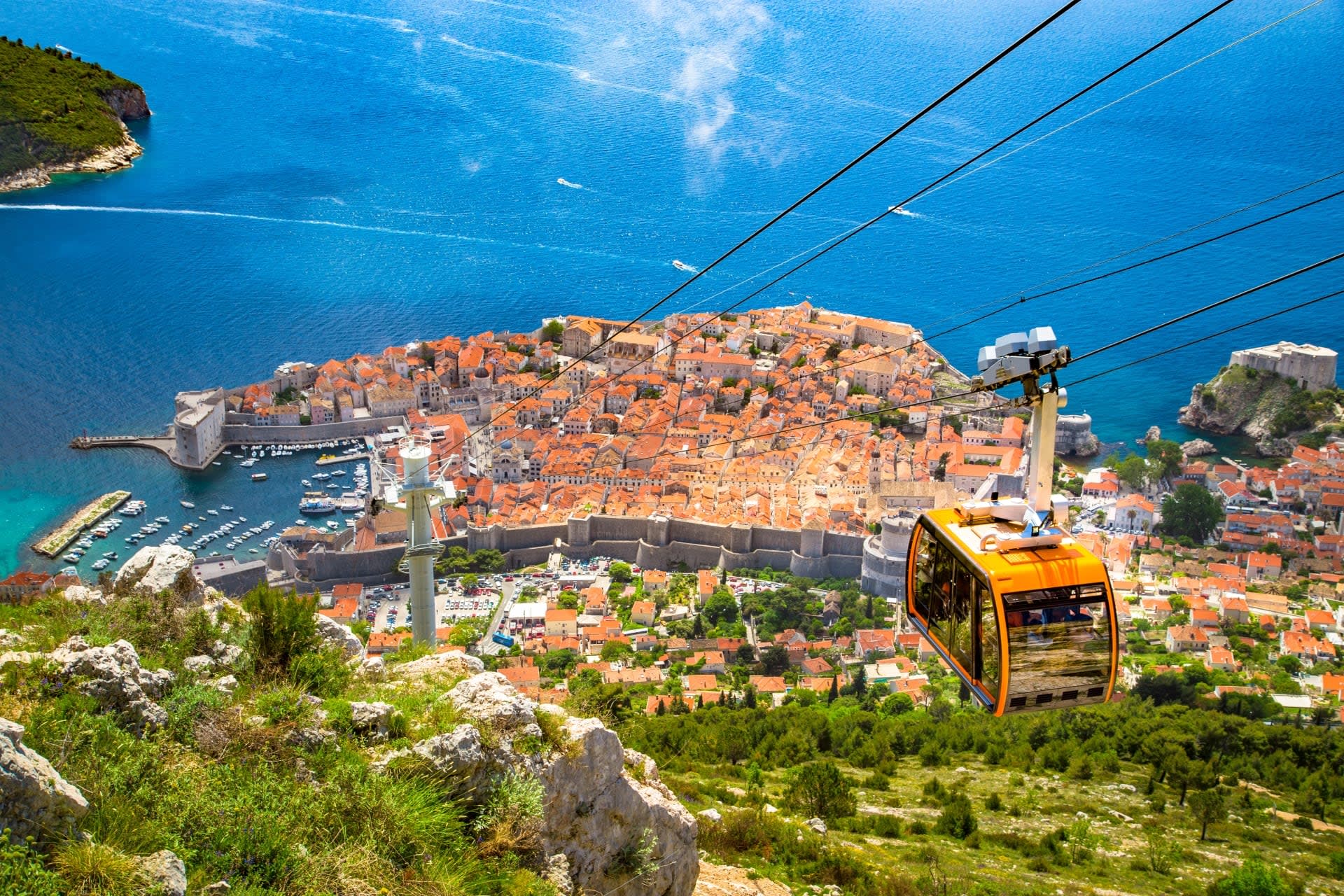Head out from Dubrovnik and explore the rural tourism offer of Konavle, a small and fertile plateau south of the city, or set out to conquer Korčula, one of the largest Croatian islands, and the Elaphite archipelago, a peaceful oasis where cars are superfluous. The Pelješac peninsula, located north of Dubrovnik, is famous for its wines and the walls that used to protect the northern border of the Republic. You can also visit Odysseus' Cave and the national park with two saltwater lakes on the island of Mljet.
Dubrovnik was used as a filming location for “Game of Thrones“, “Star Wars: Episode VIII“ and Leonardo DiCaprio's “Robin Hood“
The food here is Mediterranean and the local climate is suitable for growing citrus fruits. We recommend that you try the oysters from Mali Ston with a glass of red wine Dingač, then a local variety of crème brûlée called rozata for dessert.
Dubrovnik
Dubrovnik is a must-visit destination when it comes to Croatia. Once you take a tour of the Walls of Dubrovnik, stroll through the main street Stradun and explore the alleys that lead to the walls, you will see for yourself why this sophisticated city has been used as a filming location for “Game of Thrones“, “Star Wars: Episode VIII“ and Leonardo DiCaprio's “Robin Hood“.
Dubrovnik has been inscribed on UNESCO's World Heritage List ever since its inception four decades ago because the beauty of the city, with its Renaissance, Gothic and Baroque façades, leaves everyone in awe. As you drive to Dubrovnik from the south, a breath-taking view of the Old Town opens up. Don't worry, though, because there is a lay-by here that is just perfect for taking photos. The top of Mount Srđ overlooking Dubrovnik is a fantastic selfie spot and you can reach it by cable car or hiking.
This historic city-state used to be a maritime powerhouse that gained clout through diplomatic prowess.
People of Dubrovnik were refreshingly reasonable throughout their history and had a penchant for hedonism, as evidenced by their villas in the surrounding area
Dubrovnik was the first country in Europe to abolish slavery and it also introduced sewage and fire safety systems, a retirement home, double-entry bookkeeping, maritime and insurance laws as early as the Middle Ages. One legal provision was particularly amusing: the city government was not allowed to make any important decisions during the period of the “jugo“, a wind that blows from the south that is usually blamed for ill moods by the inhabitants of the Adriatic Region. So, we can safely assume that the denizens of Dubrovnik were refreshingly reasonable and had a penchant for hedonism, as evidenced by their villas in the surrounding area.
Korčula Island
A perfect day in the town of Korčula, located on the island of the same name, would go something like this: after having your morning cup of coffee at a café with a view of the old town walls, you rent a boat and arrive on one of the islets just a few minutes off the coast. The first one is “occupied“, since someone is already swimming there, so you proceed to the next one and revel in the solitude of a deserted island.
 Photo: Ihor Pasternak
Photo: Ihor PasternakThe town of Korčula, an ancient trading hub, is surrounded by walls that offer a view of the myriad islets and the steep slopes of the Pelješac peninsula on the other side of the strait
Korčula is one of the largest islands in southern Dalmatia and is surrounded by some 50 islets. The town of Korčula, an ancient trading hub, is surrounded by walls that offer a view of the myriad islets and the steep slopes of the Pelješac peninsula on the other side of the strait. Two popular sandy beaches are located on the very south of the island, while somewhat more intimate areas by the sea can be reached by bicycle or on foot.
Pelješac peninsula in the south of Croatia is one of the foremost wine-producing regions in the country
Two popular theories are circulating on the island of Korčula: that this is the birthplace of Marco Polo and that Odysseus stumbled upon Circe here on this very island some 2000 years ago.
The easiest way to reach Korčula is by taking a 20-minute ferry ride from the town of Orebić on the Pelješac peninsula.
Pelješac Peninsula
The large Pelješac peninsula in the south of Croatia is one of the foremost wine-producing regions in the country, so once you start exploring the mainland you will discover small secluded wineries growing grapevines on slopes bathed in the Mediterranean sun. The most popular grape variety is Zinfandel's first cousin Plavac Mali, while the most famous vineyards are in the Dingač area. Besides wine, Pelješac also boasts some gorgeous beaches, ancient walls that used to protect the northern border of the Dubrovnik city-state, and delectable locally grown oysters.
 Photo: Wimonmat Sapthanadon
Photo: Wimonmat SapthanadonPelješac is a peninsula known for a great wine, old saltworks and fresh oysters
Orebić is famous for its sea captains, who used to build magnificent villas in the town and its long pebble beaches. The stunning historic town of Korčula, which is located on the eponymous island, is easily accessible from Orebić. The nearby village of Viganj holds the reputation of being the best windsurfing location on the Adriatic coast, while hikers who decide to climb Mount St. Elijah will be rewarded with one of the most awe-inspiring views of the Adriatic Sea.
Mljet Island has often been confused with Malta throughout history
Ston is known for its old saltworks and Mali Ston is famous for its oysters. These two towns are connected by walls spanning several kilometres, which once protected the northern border of the Republic of Ragusa.
Mljet Island
Mljet is a unique green oasis, one of just a few Adriatic islands that are completely covered in Mediterranean forests. A must-see is the Mljet National Park, located in the northern part of this elongated and narrow island where lush Mediterranean flora is preserved, as well as the two unusual “lakes“, Veliko (Large) and Malo (Small), which are connected to the sea by a narrow channel. There is an islet in Large Lake with an old monastery and you can find the remains of an ancient Roman villa in the nearby cove.
 Photo: Opis Zagreb
Photo: Opis ZagrebA popular theory on Mljet has it that this cave was the place where Odysseus encountered the nymph Calypso
Now, how about this disputed claim: due to the similarities between their names, Mljet has often been confused with Malta (Melita and Meleda) throughout history and because of this, the island just might have been short-changed. Some think that Maltese dogs should be called “Mljetese“ because certain ancient historians believed that these adorable fluffers originate from Mljet. Two other popular theories that have taken root on Mljet speculate that it was here that Odysseus encountered the nymph Calypso, who held him captive in her cave for seven years, and that St. Paul shipwrecked on Mljet rather than Malta.
Besides the three large islands, the Elaphites comprise a dozen mostly uninhabited islets
St. Paul's Rock has borne the name of the shipwrecked saint for quite some time now, while the moniker Odysseus' Cave is more recent.
When describing Calypso's island, Homer said that it was an „enchanting island covered in green forests“. The Adriatic theory of the Odyssey may or may not be true, but the description is undoubtedly fitting.
Elaphite Islands
The group of islands commonly known as the Elaphites – with Lopud, Koločep and Šipan being the largest ones – was the favourite summer resort of the erstwhile residents of Dubrovnik, which is evident from the posh villas and old churches that dot the island.
 Photo: nadtochiy
Photo: nadtochiyThe Island of Koločep is the southernmost inhabited island in Croatia with a population of 163. No wonder yachters love it
Šipan is the largest island in the archipelago with a single road connecting the only two villages there, while you won't find any cars at all on Koločep and Lopud. When the boats transporting the daily excursionists finally leave for Dubrovnik, the islands become tranquil again. Even during the heyday of the Dubrovnik city-state, everyday life on the islands was slow and relaxed.
Nearby fertile Konavle plateau is the perfect destination for exploring the local rural tourism offer
This is the perfect place for unwinding and spending long hot days without a care in the world!
Besides the three large islands, the Elaphites comprise a dozen mostly uninhabited islets. The name, which is of Greek origin, means “deer islands“ and it was first mentioned by several ancient geographers. It is uncertain whether deer lived on the islands or if they got the name due to their resemblance to deer when viewed from the top of Mount Srđ overlooking Dubrovnik.
Dubrovnik surrounding area
South of Dubrovnik, you will find Cavtat, a picturesque town located on the peninsula, while the nearby fertile Konavle plateau is the perfect destination for exploring the local rural tourism offer.
Mlini and Slano are tourism hubs unaffected by the hustle and bustle of the city, yet are located just a stone's throw from Dubrovnik. The Neretva River delta is famous for its mandarin plantations, eel and frog dishes, shallow riverboats and an archaeological site that dates back to the Roman period and is located in the village of Vid.
Šipan is the largest island in the archipelago with a single road connecting the only two villages there, while you won't find any cars at all on Koločep and Lopud
To reach the Neretva River delta from Dubrovnik, you have to cross two international borders, because a narrow stretch of the territory of Bosnia and Herzegovina is located here. In case you were wondering why the territory of Croatia is split into two parts, the answer is – ancient diplomacy.
The Dubrovnik city-state gave the stretch of land to the Ottoman Empire so they wouldn't share a border with the Republic of Venice, whose territory stretched to the Neretva River delta. This line of demarcation remains to this day. That is just one of the peculiarities of Dubrovnik - you can find out so much more when you visit!

